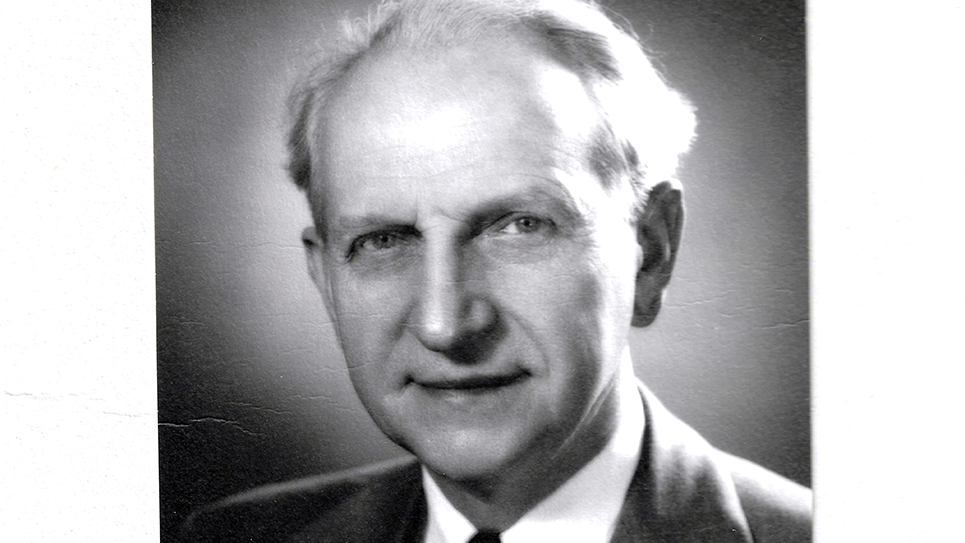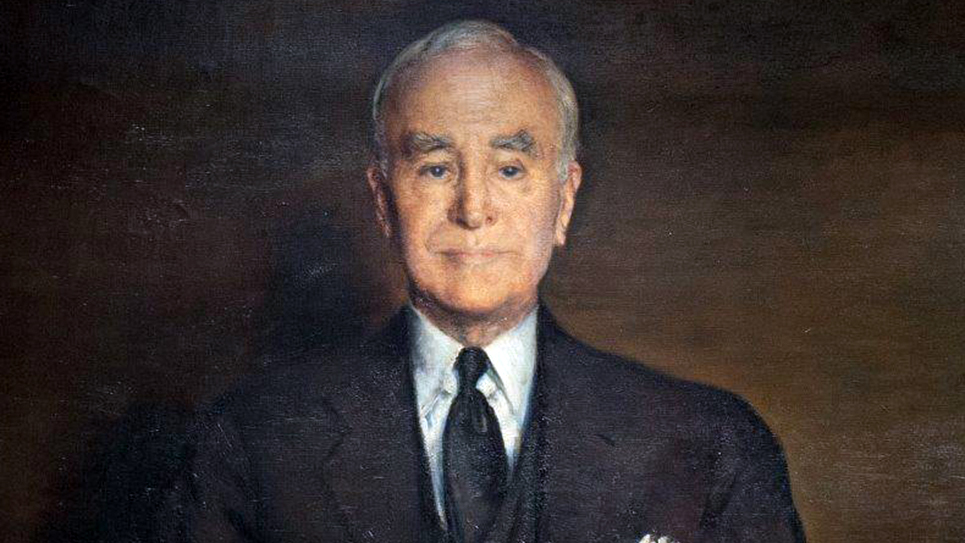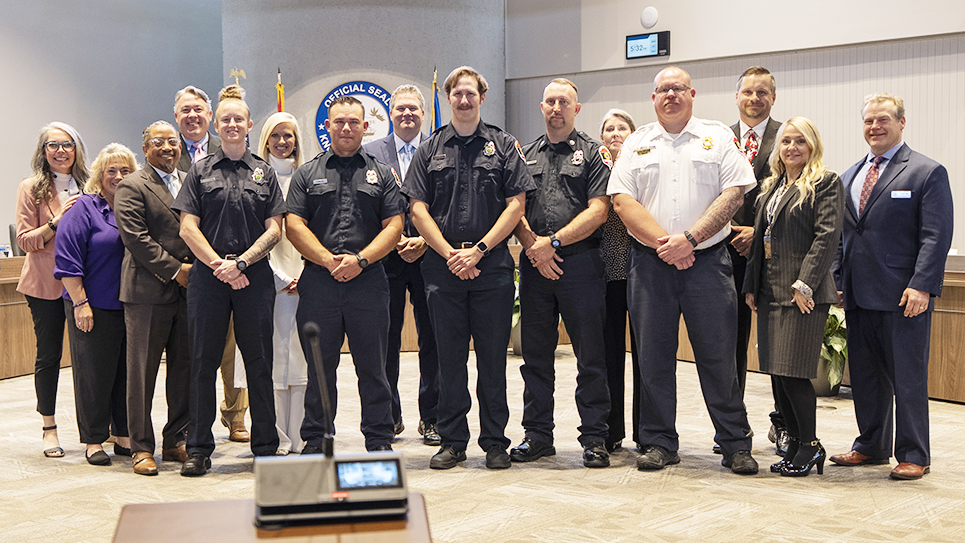The Man in the White Hat: Indiana’s Henry F. Schricker
For many years the governors of Indiana were confined to serving one four-year term and sitting it out for another four years before they could run again. Several tried, but the only man to have succeeded in making a return to the governor’s office was Henry F. Schricker, the 36th and 38th governor of the State of Indiana. Schricker’s success is all the more remarkable when one considers he was a Democrat at a time when the Republicans were once again on the ascendancy after a period of having been shut out of statewide offices. When Henry Frederick Schricker first ran for governor in 1940, he had excellent running mates in Franklin D. Roosevelt at the top of the ticket and Sherman “Shay” Minton, who was seeking to win a second term in the United States Senate. As the ballots began trickling in, it became readily apparent the gubernatorial election between Henry Schricker and GOP candidate Glenn R. Hillis was incredibly close. While the presidential and senatorial elections were also close, FDR faced Hoosier native Wendell Willkie and was trailing by a few thousand votes. Likewise, Senator Shay Minton was running slightly behind Raymond Willis, a country editor who had quite nearly beaten senior U.S. Senator Frederick Van Nuys two years earlier. Eventually, Willkie prevailed by just over 25,000 votes, while Willis won by just over 24,000. Henry F. Schricker accomplished what few others could do by running ahead of Franklin Delano Roosevelt. Schricker beat Glenn Hillis by 3,963 out of more than 1,775,000 votes cast for the two party candidates.
Henry Schricker had demonstrated immense appeal and had obviously won the votes of several thousand Republicans who did not support either President Roosevelt or Senator Minton. Schricker had been the personal choice of then-Governor Paul V. McNutt, leader of the Democratic political machine in the Hoosier State, to run with Clifford Townsend in 1936. McNutt believed Schricker could help to draw GOP votes to the Democratic ticket. Schricker’s campaign symbol was a white hat, which was his personal trademark. Throughout his campaigns for statewide office, Schricker used campaign buttons with nothing on them save for a white hat.
The 1940 election saw the Democratic victories of 1932 and 1936 largely swept away. For the first time in fifteen years, Republicans had won large majorities in the state legislature. While Schricker was certainly thought to be more conservative than his predecessor, Clifford Townsend, the newly elected governor was sure to have numerous disputes with the GOP legislative majorities over policy matters.
The expected clash with the Republican General Assembly was not long in coming. The legislature quickly passed legislation designed to sharply pare away the governor’s authority to direct agencies of state government as well as the authority to appoint various officials. The governor complained the legislature was attempting to reduce his status to that of a mere “errand boy.” Governor Schricker promptly vetoed the bill, but in Indiana, only a simple majority was required to override a veto by the chief executive. The Indiana General Assembly promptly overrode Schricker’s veto. Nor was the legislature done with trying to remove the governor as the state’s chief executive in all but name. The legislature passed the State Administration Act of 1941, which placed the state government of Indiana into five departments, only one of which, coincidentally the smallest of the five, answered to the governor. The other four were to be placed under the authority of a three-member board of commissioners. The three member board was to be comprised of the governor and two other members designated by the state legislature. Governor Schricker promptly filed suit in state courts claiming the bill violated the division of powers as stated by Indiana’s Constitution. Schricker won the lawsuit on a vote of 4-1 on the Indiana State Supreme Court.
Barred from running for governor again in 1944, Schricker was without dispute the strongest candidate Democrats could run for the United States Senate. The seat had been held for two terms by Frederick Van Nuys, who had died suddenly in January 1944. Schricker appointed Samuel Jackson to fill the seat and Jackson became the Democratic candidate for governor. TIME magazine described the 61-year-old Governor Schricker as “homespun” and “mild.” According to the TIME magazine correspondent, the secret to Schricker’s political success was having “eaten fried chicken in almost every church basement in Indiana.” Schricker concentrated on his own campaign and avoided conversations about FDR seeking a fourth term.
Schricker’s GOP opponent was chunky, balding, cigar-smoking Homer Capehart, a millionaire businessman whose company manufactured jukeboxes and phonographs (stereos) and was readying his business to begin the manufacture of television sets. Capehart had never been elected to public office previously, but he had been a stalwart of the Willkie campaign and sponsored one of the big events of the campaign known as the “Cornfield Conference.”
1944 was a Republican year in Indiana. Thomas Dewey and running mate John Bricker of Ohio carried the Hoosier State by more than 94,000 votes. Local Democrats fared better than President Roosevelt with Samuel D. Jackson losing to Republican Ralph Gates by 46,000 votes. There were two elections on the Indiana ballot for the United States; one for the full six-year term, which was the contest between Homer Capehart and Henry F. Schricker. The second was for the interim term, which ran from the November election until January 3, 1945. The Republican candidate was William E. Jenner, a young attorney who was still in uniform as the war was coming to an end. Jenner faced Democrat Cornelius O’Brien. Jenner beat O’Brien by almost 70,000 votes while Capehart only narrowly defeated Schricker by less than 22,000 ballots. Once again, Henry F. Schricker had demonstrated he could pull more votes from Independents and Republicans than any other Democrat in Indiana.
Following his loss of the 1944 Senate race, Schricker returned to the banking business, joining the American Fletcher National Bank & Trust Company, but he never really stopped campaigning. It was clear to most everyone the former governor had not given up his political ambitions. Democrats wanted to win the governorship and even those who didn’t much like Schricker readily conceded he was the most popular candidate they could nominate. By 1947, there was constant talk amongst the political class urging Henry Schricker to run for governor once again. That talk was briefly chilled when the former governor revealed he was being considered for an appointment to become the military governor of a German State following the Second World War. As to whether he would accept the appointment, Henry Schricker had literally nothing to say, leaving the political class in Indiana stunned. An editorial in the Indianapolis Star stated its suspicion that it was nothing more than an attempt to stir the political pot further.
The former governor was clearly campaigning, attending a reception in his honor at the home of friends, which drew 100 people. The governor had been in Tipton, Indiana, that same day to speak to a Rotary Club as well as the Elwood Business and Professional Women’s Club. Nobody was surprised when Henry F. Schricker announced he would attempt to return to the governor’s mansion in 1948.
An editorial appearing in the Booneville Enquirer was typical of many small newspapers that endorsed the former governor for his old job. The editorial stated Schricker had been “a great wartime Governor” and had “kept close to the people” even after his term of office had expired. The newspaper published the familiar white hat, which it declared to be “the symbol of good government” in Indiana. Writer Ralph Brooks thought the “flashy fedora worn jauntily” by Henry Schricker was the “most unique political trademark” in the Hoosier State. According to Brooks, ham and eggs were no better a fit than the white hat was for Schricker.
The 65-year-old candidate was busy stumping Indiana, making three speeches a day. At the beginning of his campaign, the former governor did his own driving before grudgingly agreeing to use a driver. Schricker’s ready acceptance of every invitation to speak before a group of Indianans was paying handsome dividends. Henry Schricker was a familiar presence at every service organization, club and lodge in the State of Indiana.
Thomas E. Dewey once again carried Indiana in the 1948 presidential contest but only managed to eke out a narrow victory of some 13,000 votes. At the same time, Henry F. Schricker won a decisive majority of more than 139,000 votes against GOP nominee Hobart Creighton to return to the governorship. Henry F. Schricker was the only person ever to win a second term as governor of Indiana at the time.
Schricker’s win helped to carry a Democratic majority into the General Assembly for the first two years of his second administration as governor. When the Republicans won back a majority in 1950, the relationship between the chief executive and the legislative branch once again became more contentious.
Always ready to promote his state of Indiana and himself, Governor Schricker appeared as himself in the movie “Johnny Holiday,” the plot of which featured a youngster on the verge of becoming a juvenile delinquent in Indiana. The movie also featured entertainer Hoagy Carmichael, himself a native of the Hoosier State.
Never a spender, Governor Henry F. Schricker left the State of Indiana with a $115 million surplus when he retired in 1953. Not done with politics, Schricker was a candidate for the United States Senate once again in 1952. The incumbent was William E. Jenner who had been elected to a full six-year term upon returning from the Second World War in 1946. Jenner was a highly controversial member of the U.S. Senate, a rock-solid conservative; some would even categorize Jenner as being far to the right. The senatorial contest pitted two incumbents against one another in the general election, both of whom were well-known to the voters of the state. Yet the personalities of the two candidates were poles apart. The courtly and mild Schricker was a grandfatherly figure while the young Jenner was energetic, combative and plain-spoken to the point of being blunt.
Schricker had enthusiastically supported the presidential candidacy of Adlai Stevenson, the governor of neighboring Illinois. Governor Schricker was one of those prominent Democrats selected to give the nominating speech for Stevenson at the Democratic National Convention. Yet the Republicans nominated Dwight D. Eisenhower, who was quite likely the most personally popular man in the country at the time. The Eisenhower-Nixon ticket won Indiana by almost 335,000 votes. Once again, Schricker defied the odds by running far ahead of his own party’s ticket, but Eisenhower’s huge majority in the state helped to propel Senator Jenner to another term in the United States Senate. Jenner was victorious by almost 109,000 ballots.
After retiring as governor and being denied a seat in the U.S. Senate, Schricker wasted no time in organizing the Wabash Fire & Casualty Insurance Company, of which he became chairman. Politically, Schricker gracefully accepted his own role as an elder statesman of the Democratic Party and as a former governor of Indiana. Schricker remained a much sought-after speaker for clubs and organizations and aspiring politicians and prospective candidates continued to seek him out for his advice and counsel. The former governor continued working until he was 80 and finally retired to the small town of Knox.
When the former governor died in 1966, the tributes came rolling in. Governor Roger Branigan said, “What a delightful person he was – – – honorable in his dealings, warmhearted in his ways with young and old, thoughtful of others.” Branigan remembered Schricker as “one of the most persuasive speakers of our day” who had “become a legend in his own lifetime.” Former GOP Governor Ralph Gates agreed Schricker was honest and “forthright in his dealings” and added, “I never knew him to inject partisan politics into state government.”
As tributes go, being a legend in one’s own time is a pretty good one. © 2023 Ray Hill







